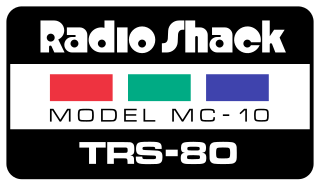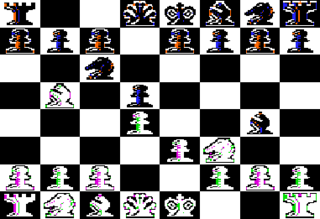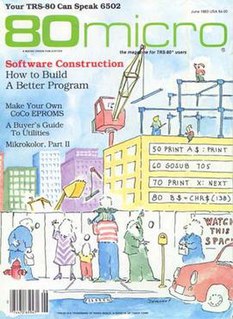Related Research Articles

The Apple II is an 8-bit home computer and one of the world's first highly successful mass-produced microcomputer products. It was designed primarily by Steve Wozniak; Steve Jobs oversaw the development of Apple II's foam-molded plastic case and Rod Holt developed the switching power supply. It was introduced by Jobs and Wozniak at the 1977 West Coast Computer Faire, and marks Apple's first launch of a personal computer aimed at a consumer market—branded toward American households rather than businessmen or computer hobbyists.

The Dragon 32 and Dragon 64 are home computers that were built in the 1980s. The Dragons are very similar to the TRS-80 Color Computer, and were produced for the European market by Dragon Data, Ltd., initially in Swansea, Wales before moving to Port Talbot, Wales and by Eurohard S.A. in Casar de Cáceres, Spain, and for the US market by Tano of New Orleans, Louisiana. The model numbers reflect the primary difference between the two machines, which have 32 and 64 kilobytes of RAM, respectively.

The TRS-80 Micro Computer System is a desktop microcomputer launched in 1977 and sold by Tandy Corporation through their Radio Shack stores. The name is an abbreviation of Tandy Radio Shack, Z80 [microprocessor]. It is one of the earliest mass-produced and mass-marketed retail home computers.

The RadioShack TRS-80 Color Computer, later marketed as the Tandy Color Computer and sometimes nicknamed the CoCo, is a line of home computers developed and sold by Tandy Corporation. Despite sharing a name with the earlier TRS-80, the Color Computer is a completely different, incompatible system and a radical departure in design and compatibility with its Motorola 6809E processor rather than the Zilog Z80 earlier models were built around.

VisiCalc is the first spreadsheet computer program for personal computers, originally released for Apple II by VisiCorp in 1979. It is often considered the application that turned the microcomputer from a hobby for computer enthusiasts into a serious business tool, prompting IBM to introduce the IBM PC two years later. VisiCalc is considered to be Apple II's killer app. It sold over 700,000 copies in six years, and as many as 1 million copies over its history.

A microcomputer is a small, relatively inexpensive computer having a central processing unit (CPU) made out of a microprocessor. The computer also includes memory and input/output (I/O) circuitry together mounted on a printed circuit board (PCB) Microcomputers became popular in the 1970s and 1980s with the advent of increasingly powerful microprocessors. The predecessors to these computers, mainframes and minicomputers, were comparatively much larger and more expensive. Many microcomputers are also personal computers. An early use of the term personal computer in 1962 predates microprocessor-based designs. (See "Personal Computer: Computers at Companies" reference below). A microcomputer used as an embedded control system may have no human-readable input and output devices. "Personal computer" may be used generically or may denote an IBM PC compatible machine.

The Commodore VIC-20 is an 8-bit home computer that was sold by Commodore Business Machines. The VIC-20 was announced in 1980, roughly three years after Commodore's first personal computer, the PET. The VIC-20 was the first computer of any description to sell one million units. It was described as "one of the first anti-spectatorial, non-esoteric computers by design...no longer relegated to hobbyist/enthusiasts or those with money, the computer Commodore developed was the computer of the future."
Microsoft BASIC is the foundation software product of the Microsoft company and evolved into a line of BASIC interpreters adapted for many different microcomputers. It first appeared in 1975 as Altair BASIC, which was the first version of BASIC published by Microsoft as well as the first high-level programming language available for the Altair 8800 microcomputer.

The TRS-80 MC-10 microcomputer is a lesser-known member of the TRS-80 line of home computers, produced by Tandy Corporation in the early 1980s and sold through their RadioShack chain of electronics stores. It was a low-cost alternative to Tandy's own TRS-80 Color Computer to compete with entry-level machines such as the Commodore VIC-20 and Sinclair ZX81.

Sargon is a line of chess-playing software for personal computers. The original SARGON from 1978 was written in assembly language by Dan and Kathleen "Kathe" Spracklen for the Z80-based Wavemate Jupiter III.

The TRS-80 Model 100 is a portable computer introduced in 1983. It is one of the first notebook-style computers, featuring a keyboard and liquid crystal display, in a battery-powered package roughly the size and shape of a notepad or large book.

The Rainbow was a monthly magazine for the TRS-80 Color Computer by the Tandy Corporation. It was started by Lawrence C. Falk and was published from July 1981 to May 1993 by Falk's company, Falsoft, which was based in Prospect, Kentucky.

Scripsit is a word processing application written for the Radio Shack TRS-80 line of computers. Versions were available for most if not all computers sold under the TRS-80 name, including the Color Computer and several pocket computer designs, as well as the Tandy version of the Xenix operating system. Tandy Corp. also produced a version running under MS-DOS for its line of PC compatible computers. Some of the 8-bit versions are tape-based and have no ability to read or write to disk.

80 Micro was a computer magazine, published between 1980 and 1988, that featured program listings, products and reviews for the TRS-80.

The history of the personal computer as a mass-market consumer electronic device began with the microcomputer revolution of the 1970s. A personal computer is one intended for interactive individual use, as opposed to a mainframe computer where the end user's requests are filtered through operating staff, or a time-sharing system in which one large processor is shared by many individuals. After the development of the microprocessor, individual personal computers were low enough in cost that they eventually became affordable consumer goods. Early personal computers – generally called microcomputers – were sold often in electronic kit form and in limited numbers, and were of interest mostly to hobbyists and technicians.

The TRS-80 Model II is a computer system launched by Tandy in October 1979, and targeted at the small-business market. It is not an upgrade of the original TRS-80 Model I, but a new system.

Home computers were a class of microcomputers that entered the market in 1977 and became common during the 1980s. They were marketed to consumers as affordable and accessible computers that, for the first time, were intended for the use of a single nontechnical user. These computers were a distinct market segment that typically cost much less than business, scientific or engineering-oriented computers of the time such as those running CP/M or the IBM PC, and were generally less powerful in terms of memory and expandability. However, a home computer often had better graphics and sound than contemporary business computers. Their most common uses were playing video games, but they were also regularly used for word processing and programming.
Extended Color Basic is an update to the Color BASIC interpreter for the Radio Shack/Tandy TRS-80 Color Computer series and is the default Basic interpreter, for the Color Computer 2. The Color Computer Basic implementations are somewhat different for the versions of Basic which come with the other family of TRS-80 machines, namely Basic Levels I, II, and III. Assemblers and Pascal and C compilers are available for the different machines in the series. Modified subsets of Color Basic may be found on many of the Radio Shack PC series of pocket computers of the era.
Disk Extended Color Basic is an update to the Color BASIC interpreter for the Radio Shack/Tandy TRS-80 Color Computer series and is the default BASIC interpreter, and therefore the de facto operating system, for the Color Computer 3. The Color Computer Basic implementations are somewhat different for the versions of Basic which come with the other family of TRS-80 machines, namely Basic Levels I, II, and III. Assemblers and Pascal and C compilers are available for the different machines in the series. Modified subsets of Color Basic may be found on many of the Radio Shack PC series of pocket computers of the era.
References
- ↑ "The "CoCo" Chronicles".
- ↑ William Barden Jr. "Interfacing Tricks for BASIC and Assembly Language". The Rainbow Magazine (July 1986): 216–223.
- 1 2 "LibraryThing page on William T Barden".
- ↑ "Personal page on William Barden Jr.'s personal site". Archived from the original on 2014-08-14.
- ↑ "The Rainbow Magazine (Radio Shack Color Computer) (December 1990)". December 1990.
- 1 2 3 "Ira Goldklang's TRS-80 Revived Site".
- 1 2 "Resume page on William Barden Jr.'s personal site". Archived from the original on 2014-08-14.